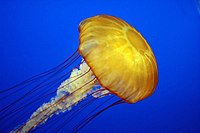
Photo from wikipedia
Salinity is hypothesized to influence the abundance of scyphozoan medusae in the East Asian Marginal Seas, as their spawning largely coincides with the summer monsoon season, and extreme rainfalls subject… Click to show full abstract
Salinity is hypothesized to influence the abundance of scyphozoan medusae in the East Asian Marginal Seas, as their spawning largely coincides with the summer monsoon season, and extreme rainfalls subject planulae to reduced salinity, presumably jeopardizing the recruitment of polyps. We examined the effects of different salinities (5, 10, 15, 20, 25, and 32) on body size, swimming speed, survivorship and settlement of planulae, and subsequent development of metamorphosed polyps of three bloom-forming scyphozoans: Chrysaora pacifica, Nemopilema nomurai, and Rhopilema esculentum. Their physiology and behaviors were affected by osmotic stress, but differed by species. At 5, planulae of all species died. At 10, C. pacifica could not settle but survived as plankton, whereas N. nomurai and R. esculentum could settle and develop into four-tentacle polyps, yet the former showing delayed development and tentacle abnormalities. The lowest salinities permitting normal recruitment of polyps were 10, 15, and 20 for R. esculentum, N. nomurai, and C. pacifica, respectively. Inter-annual variations in monsoon rainfall can alter hydrographic conditions in the polyp habitats, affecting medusa population sizes in the following year. The robustness to low salinity of R. esculentum and N. nomurai larvae may enable them to establish yet-to-be-identified polyp populations in brackish-water environments.
Journal Title: Hydrobiologia
Year Published: 2018
Link to full text (if available)
Share on Social Media: Sign Up to like & get
recommendations!